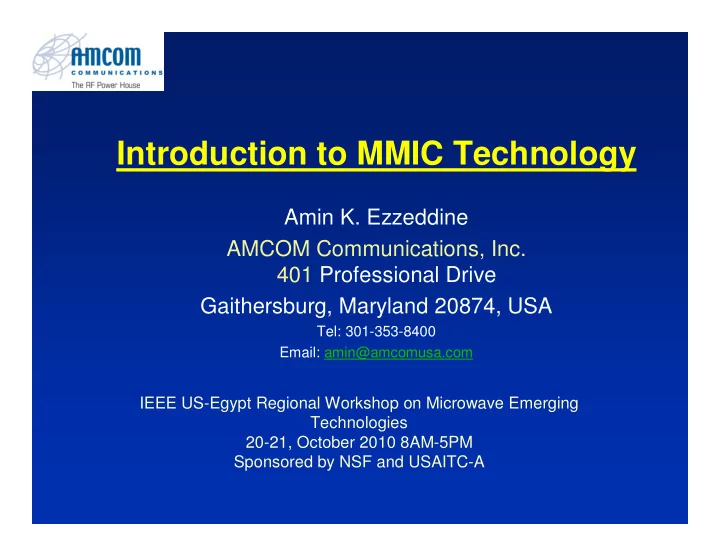

Introduction to MMIC Technology Amin K. Ezzeddine AMCOM Communications, Inc. 401 Professional Drive Gaithersburg, Maryland 20874, USA Tel: 301-353-8400 Email: amin@amcomusa.com IEEE US-Egypt Regional Workshop on Microwave Emerging Technologies 20-21, October 2010 8AM-5PM Sponsored by NSF and USAITC-A
Presentation Outline • Introduction to MMICs • MMIC applications • State-of-the -art MMIC technologies • New business challenges • Conclusion and future trends
History of the MMIC • Jack Kilby Kilby built the first IC at TI in 1958 for which he got built the first IC at TI in 1958 for which he got • Jack the Nobel Prize in Physics in 2000 the Nobel Prize in Physics in 2000 • Jean A. Hoerni Hoerni at Fairchild invented the Planar process at Fairchild invented the Planar process • Jean A. on Silicon in 1958 on Silicon in 1958 • In 1975 Ray Pengelly Pengelly and James Turner at6 Plessey and James Turner at6 Plessey • In 1975 Ray built the first MMIC at X- -Band: Band: "Monolithic Broadband "Monolithic Broadband built the first MMIC at X GaAs F.E.T. Amplifiers" F.E.T. Amplifiers" GaAs • In 1987 H. Hung et al at COMSAT built the 1 st mm-wave MMIC at 20GHz "Ka-Band monolithic GaAs power FET amplifiers" • MMIC stands for Monolithic Microwave Integrated Circuits
MIC versus MMIC Solution? • MIC Advantages: • MIC Advantages: – Fast & Low Cost Development Fast & Low Cost Development – – Better Performance such as: NF, Efficiency, P Better Performance such as: NF, Efficiency, P 1dB – 1dB – Variety of Dielectric Materials Variety of Dielectric Materials – – Integration of Different Semiconductor Technologies: Integration of Different Semiconductor Technologies: – MESFETs, Bipolar, Pin Diodes, Digital , Bipolar, Pin Diodes, Digital… …etc etc MESFETs – Higher Levels of Integration is possible Higher Levels of Integration is possible – • MMIC Advantages: – Low unit Cost – Performance Uniformity from Unit to Unit – Very Small Size & Weight – Very Broadband Performance due to few parasitic effects – Simple Assembly Procedure
3 Generations of a 10W PA
MMIC Applications – Switches: SPDT, SPNT, NPMT, ..etc Switches: SPDT, SPNT, NPMT, ..etc – – Amplifiers: Amplifiers: LNAs LNAs, , PAs PAs, Drivers , Drivers – – Attenuators: Fixed, variable, digital Attenuators: Fixed, variable, digital – – Phase Shifters: Fixed, variable, digital Phase Shifters: Fixed, variable, digital – – Mixers Mixers – – Frequency Multipliers Frequency Multipliers – – VCOs VCOs – – Phase Detectors Phase Detectors – – MMIC World market is around $5billion MMIC World market is around $5billion – versus a total of $1Trillion electronics versus a total of $1Trillion electronics market market
GaAs Market 1999 – 2011
MMICs for Wireless Applications T/R SW PA Modulator LNA Mixer IF Amp RF Front End for ETC Applications MMIC PA for 802.11b
Power Amplifier MMICs 250mW 2 – 25GHz Millimeter-wave PA 4W 0.03 to 3GHz MMIC Die Size 2.2x1.8mm
Passive MMICs 44GHz 4-bit Phase Shifter MMIC DC – 40GHz SPDT Switch
MMIC Integration TX To BB RX Bias & Control Pins
Trends For Commercial Applications • Multi-Function, Multi-Frequency Band MMIC: Combine switch, LNA, PA, Mixer on one chip (HBT, Enhancement-mode PHEMT, and depletion-mode PHEMT on one chip) • SOC (System on One Chip): Including Baseband, IF and RF on one chip. • MMIC for 4G (Smart Phone) growing market: - WiMAX (Worldwide Interoperability for Microwave Access): 1-20Mb/s - LTE (Long-Term Evolution): 5-12 Mb/S
Trends for Government Applications • Applications: - Software radio broadband communications - High power broadband jammers - Phase Array Radars - mm-Wave • Novel MMIC technologies: - GaN HEMT - HIFET
Semiconductor Materials for MMICs MMIC RF Active Device Electron � r Thermal Application Semiconductors loss Technology Mobility MESFET, HEMT, PA, LNA, mixers, Gallium Arsenide 0.85m 2 /V/s 12.9 Low 46 W/ºC/m pHEMT, HBT, attenuators, (GaAs) mHEMT switches, …etc LDMOS, RF Mature for low power Silicon (Si) 0.14m 2 /V/s 11.7 High 145 W/ºC/m CMOS, SiGe mixed signal HBT (BiCMOS) applications Very high power Silicon Carbide (SiC) 0.05m 2 /V/s 10 Low 430 W/ºC/m MESFET below 5GHz Indium Phosphide 0.60m 2 /V/s 14 Low 68 W/ºC/m MESFET, HEMT mm-wave (InP) Gallium Nitride High power, limited 0.08m 2 /V/s 8.9 Low 130 W/ºC/m HEMT (GaN) availability
MMIC Recommended Processes Application Frequency Device Process 1-10GHz GaAs Mesfet 10 –100Ghz GaAs pHEMT Low Noise Amplifiers > 100GHz InP Medium Power (< 10W) 1 -10GHz GaAs HBT, GaAs Mesfet 10 – 100GHz pHEMT 1 - 10GHz GaAs Mesfet, GaN, SiC High Power (> 100W) 10 – 30GHz GaN 0.1 – 20GHz Mesfet Switches for digital attenuators and phase shifters 20–100GHz pHEMT Low Power Mixed Signal 1 – 50GHz SiGe BiCMOS VCO 1 -100GHz GaAs HBT
MMIC Packaging c) SMT Plastic b) SMT Ceramic a) Ceramic Drop-in d) Finished Products
New Business Challenges • Starting a business is risky but challenging - Less than 5% of new startups are successful - Idea , market and team players - Convincing business plan • Minimum capital to start a Fabless semiconductor facility is around $10,000,000 • Maintaining cash balance for 3 – 6 months operations • Need State-of-The-Art Testing and Assembly equipment • High Cost of development - New MMIC Mask & wafer costs: $50,000 - $150,000 - Design mistakes are expensive - Extended manufacturing schedule: 6 – 9 months • Rapid technological developments
Conclusion and Future Trends • GaAs MMICs dominate power, low noise and passive applications at microwave and will continue to do so in the foreseeable future • BiCMOS & SiGe MMICs is maturing for SOC and RF front end applications • GaN MMICs are expected to mature in few years and may fulfill the need for 10W to 100W power levels up to mm- waves • SiC and LDMOS Silicon MMIC will continue to serve applications for >10W below 5GHz • 3-D MMICs will mature for mm-waves and higher level of integration in Silicon
Recommend
More recommend